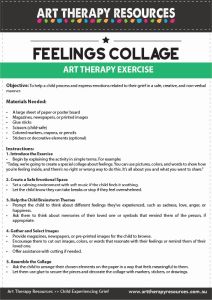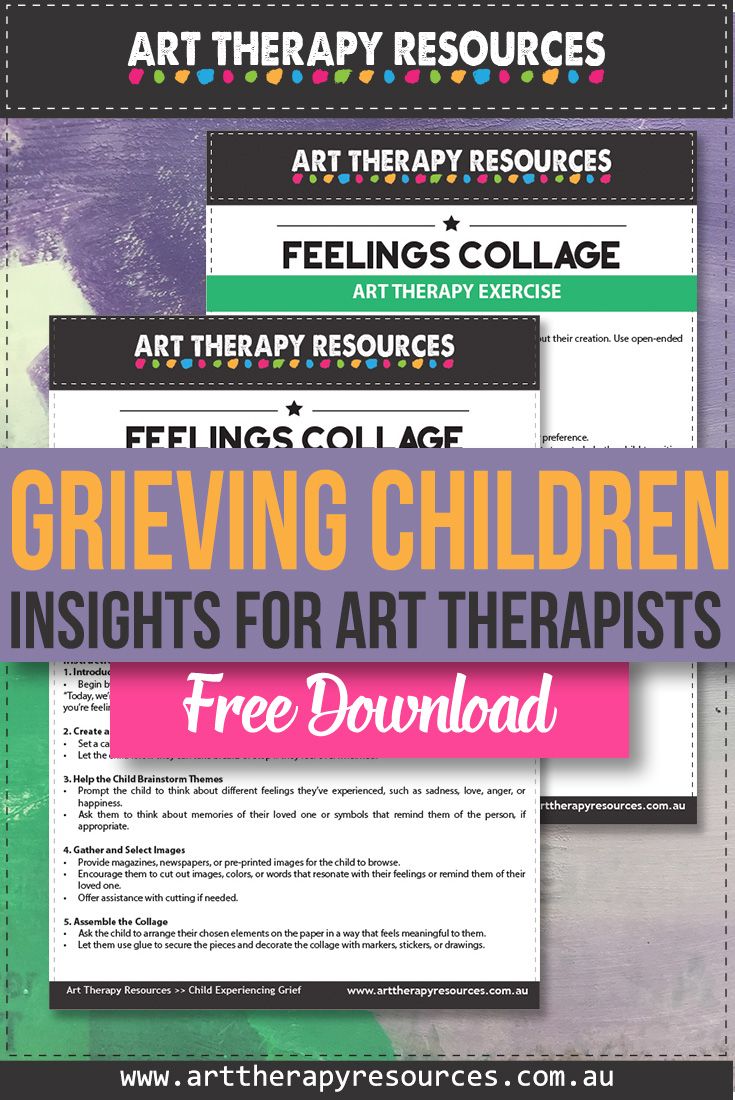UNDERSTANDING GRIEF IN CHILDREN
Grief and loss are deeply personal experiences that manifest differently across individuals, particularly in children and adolescents. For art therapists, understanding the nuanced ways grief affects younger clients can significantly enhance therapeutic practices and provide a framework for fostering emotional expression and healing through art. This blog post explores key aspects of grief in children, its manifestations, and how art therapy can serve as a medium to help children navigate their way through the process of grief.
Children often grieve in non-linear and unexpected ways. A child may seem unaffected one day but exhibit profound sadness the next. Their age, developmental stage, family dynamics, and the nature of the loss all influence how they process grief.
Key considerations include:
- Developmental Understanding: Younger children may not fully grasp the permanence of death and might repeatedly ask when the deceased will return. Older children may demonstrate anger, difficulty concentrating, or changes in academic performance.
- Behavioral Expression: Children often express grief through actions rather than words, which may seem demanding or unreasonable. Recognizing these behaviors as manifestations of grief is critical for guiding interventions.
Common Reactions to Grief
Children’s emotional and physical responses to grief are varied and may include:
- Emotional Responses:
- Shock: Initial disbelief or feeling that the event is unreal.
- Longing: A persistent yearning for the deceased, sometimes accompanied by fantasies of their return.
- Anger: Feelings of abandonment or resentment.
- Guilt: Self-blame for perceived actions or inactions.
- Anxiety: Heightened fears about the future or losing others.
- Physical Responses:
- Complaints of stomach aches, headaches, or other physical pains.
- Sleep disturbances, including nightmares or a need to sleep near loved ones.
- Appetite changes and difficulties concentrating.
- Cognitive Responses:
- Persistent thoughts or preoccupation with the deceased.
- Idealization of the person who has died.
- Misattribution of responsibility for the death, particularly among younger children.
Art therapists can explore these responses through creating art and thereby enable children to externalize and process complex emotions.
THE ROLE OF ART THERAPY IN GRIEF WORK
Art therapy offers a unique, non-verbal medium for children to express feelings that may be too overwhelming or abstract to articulate. Here’s how art therapy can support grieving children:
- Creating a Safe Space: Art therapy provides a structured yet flexible environment where children feel secure enough to explore their grief. This sense of safety is crucial for children, especially when their world feels unstable.
- Facilitating Emotional Expression: Through drawing, painting, sculpting, or other creative processes, children can externalize their emotions. For example, a child might draw a memory with the deceased or use colours to represent feelings of sadness, anger, or fear.
- Normalizing Grief Reactions: Incorporating psychoeducation into sessions helps children understand that their feelings are normal and valid. Therapists might use visual aids or storytelling to illustrate the commonality of grief responses.
- Memory Preservation: Art can serve as a tool to commemorate and honor the deceased. Projects like creating memory boxes, photo collages, or symbolic art pieces can help children feel connected to their loved one while fostering a sense of closure.
- Building Resilience: Engaging in art therapy can empower children by giving them a sense of agency in their healing process. It helps them navigate the complexities of grief and reinforces their ability to cope.
TAILORING ART THERAPY BY AGE GROUP
Preschool Children
Preschoolers often view death as temporary and may display regressive behaviours, separation anxiety, or repetitive questions about the deceased.
Art activities for this group might include:
- Creating simple drawings about their feelings.
- Using puppets or storytelling to explain death.
- Engaging in soothing sensory activities, like finger painting, to address anxiety.
Primary School Children
By age 8, children begin to understand the permanence of death but may struggle with guilt, withdrawal, or misbehaviour. Suitable art therapy interventions include:
- Memory-making projects, such as decorating picture frames or creating a “life book” about the deceased.
- Collaborative art activities with family members to rebuild a sense of security.
- Exploring emotions through structured art prompts, like “Draw a time when you felt safe.”
Adolescents
Adolescents may exhibit a broader emotional range, including anger, risk-taking, or withdrawal. They also tend to fluctuate between seeking independence and craving support. Art therapy approaches can involve:
- Individual projects, such as abstract art representing their “inner world.”
- Group sessions to foster peer support and shared experiences.
- Creative outlets for storytelling, songwriting, or journaling alongside visual art.
INTEGRATING ART THERAPY WITH OTHER SUPPORTS
For optimal outcomes, art therapy should be part of a holistic support system that includes family, school, and community resources. Suggestions for integration include:
- Family Engagement: Encourage families to participate in collaborative art activities, which can strengthen bonds and open communication. For example, a family art project might involve creating a shared “memory mural” to honour the deceased.
- School-Based Programs: Work with teachers and counsellors to establish grief-focused art workshops or support groups within schools. These programs can help children process their grief in a familiar environment.
- Community Resources: Partner with local organizations or support groups to offer additional grief resources, such as trauma-informed art programs or memorial events.
Recognizing When Specialized Support is Needed
While many children exhibit resilience, some may develop mental health challenges, including depression, post-traumatic stress disorder (PTSD), or complicated grief. Art therapists should be vigilant in identifying signs that suggest a need for specialized interventions, such as persistent withdrawal, severe anxiety, or an inability to function in daily life.
Collaborating with mental health professionals ensures that children receive comprehensive care tailored to their needs.
Art therapy is a powerful modality for supporting grieving children and adolescents. By leveraging creativity and emotional expression, art therapists can provide a safe space for clients to process their grief, preserve memories, and build resilience. Incorporating age-appropriate strategies, engaging families and schools, and collaborating with other professionals will ensure a holistic approach to healing.
ART THERAPY EXERCISE FOR CHILD EXPERIENCING GRIEF
Art Therapy Exercise: Feelings Collage for Grieving Children
Objective: To help a child process and express emotions related to their grief in a safe, creative, and non-verbal manner.
Materials Needed:
- A large sheet of paper or poster board
- Magazines, newspapers, or printed images
- Glue sticks
- Scissors (child-safe)
- Colored markers, crayons, or pencils
- Stickers or decorative elements (optional)
Instructions:
1. Introduce the Exercise
– Begin by explaining the activity in simple terms. For example:“Today, we’re going to create a special collage about feelings. You can use pictures, colors, and words to show how you’re feeling inside, and there’s no right or wrong way to do this. It’s all about you and what you want to share.”
2. Create a Safe Emotional Space
– Set a calming environment with soft music if the child finds it soothing.
– Let the child know they can take breaks or stop if they feel overwhelmed.
3. Help the Child Brainstorm Themes
– Prompt the child to think about different feelings they’ve experienced, such as sadness, love, anger, or happiness.
– Ask them to think about memories of their loved one or symbols that remind them of the person, if appropriate.
4. Gather and Select Images
– Provide magazines, newspapers, or pre-printed images for the child to browse.
– Encourage them to cut out images, colors, or words that resonate with their feelings or remind them of their loved one.
– Offer assistance with cutting if needed.
5. Assemble the Collage
– Ask the child to arrange their chosen elements on the paper in a way that feels meaningful to them.
– Let them use glue to secure the pieces and decorate the collage with markers, stickers, or drawings.
6. Reflect on the Artwork
– Once the collage is complete, invite the child to share their thoughts about their creation. Use open-ended questions like:
“Can you tell me about this part of your collage?”
“How does this picture make you feel?”
– Be attentive and validate their emotions without judgment.
7. Close the Session
– Thank the child for sharing their artwork and emotions.
– Offer to keep the collage safe or let them take it home, depending on their preference.
– End the session with a calming activity, such as deep breathing or a short story, to help the child transition back to their day.
NOTE
- Be mindful of the child’s emotional state throughout the session and offer reassurance as needed.
- This activity can be repeated over multiple sessions to explore different aspects of grief or emotions.
- If the child expresses distress, gently shift the focus to comforting imagery or memories.
This exercise aligns with the principles of providing a creative outlet for emotional expression while fostering a sense of safety and understanding for grieving children.
FREE DOWNLOAD: Art Therapy Exercise
SIGN UP below to gain access to our RESOURCE LIBRARY and download the FREE Art Therapy Exercise.

BUILD YOUR ART THERAPY REFERENCE MATERIALS:
Pin this image to your Pinterest board.

SHARE KNOWLEDGE & PASS IT ON:
If you’ve enjoyed this post, please share it on Facebook, Twitter, Pinterest. Thank you!
